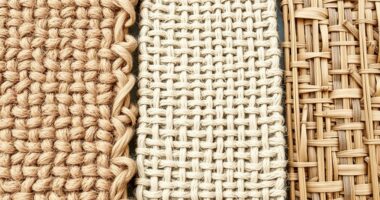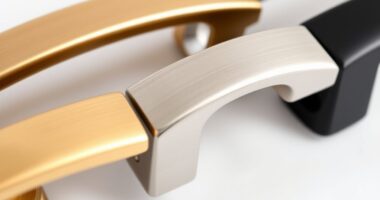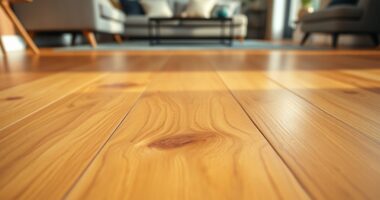Stone slab bookmatching and end-matching involve precise alignment techniques to create seamless, symmetrical surfaces. Bookmatching flips and matches slabs along their edges to produce mirrored veining and patterns, requiring careful measurement and planning. End-matching aligns adjacent slabs to minimize or hide joints, ensuring continuous flow across surfaces. Combining both techniques demands meticulous coordination and accuracy. Mastering these methods enhances aesthetic appeal; exploring further will reveal detailed steps to perfect your stone projects.
Key Takeaways
- Bookmatching involves flipping slabs to create symmetrical veining patterns for visual continuity.
- End-matching aligns the edges of slabs to ensure seamless joints in surfaces like countertops.
- Precise measurement and planning are crucial to maintain pattern symmetry and prevent visual disruptions.
- Combining both techniques requires careful slab orientation, marking, and coordination during fabrication.
- Quality control ensures accurate cuts and alignment, resulting in a cohesive, aesthetically appealing stone surface.

Stone slab bookmatching and end-matching are essential techniques in stone fabrication that guarantee seamless aesthetic continuity across surfaces. When you employ bookmatching, you align two or more slabs in a manner that creates a mirror image of the stone’s natural veining and pattern. This process involves precisely flipping and matching slabs along their edges to produce a continuous, symmetrical visual flow. It requires meticulous planning and precise measurement, as even slight deviations can disrupt the intended symmetry, leading to a less cohesive appearance. Properly executed, bookmatching enhances the natural beauty of the stone, emphasizing its unique veining and color variations, and producing a striking visual effect that appears almost deliberate in its symmetry. Incorporating precision measurement tools is vital to achieving the desired results and maintaining quality control.
Stone slab bookmatching creates a mirror image, highlighting veining and symmetry for a seamless, visually striking surface.
End-matching, on the other hand, focuses on aligning the edges of adjoining slabs to create a seamless transition across joints. This technique is particularly critical when extending surfaces such as countertops, wall claddings, or flooring that require multiple slabs. You must cut and prepare edges with high precision, ensuring that the joint lines are tight and the surface continuity is maintained. This involves accurately matching the thickness and surface plane of adjoining slabs and often requires the use of specialized tools like calibrated saws and edge polishing machines. The goal is to minimize visual interruption at joints, making them virtually invisible and maintaining the natural flow of the stone’s pattern.
Combining bookmatching with end-matching demands detailed planning and coordination. You need to consider the orientation of slabs during fabrication, ensuring that the mirroring effect aligns correctly across multiple units. This often involves marking and cataloging slabs during measurement, so that each piece is positioned correctly in relation to others during installation. It’s essential to account for natural variations in the stone, such as color shifts or veining irregularities, and to adjust your fabrication process accordingly to optimize visual harmony.
Precision in cutting, calibration, and handling is essential throughout this process. Any misalignment, even by fractions of a millimeter, can compromise the visual integrity of the pattern. Thus, you must implement strict quality control measures and use accurate measurement tools. When executed correctly, stone slab bookmatching and end-matching produce a unified, aesthetically pleasing surface with continuous veining and pattern flow, elevating the overall quality and visual appeal of your finished project.
Frequently Asked Questions
How Do I Choose the Right Stone Slabs for Matching?
You should select slabs with consistent color, pattern, and grain direction for matching. Look for slabs that have similar veining, movement, and tonal variations to guarantee seamless flow. Inspect the edges to confirm they align properly when placed together. Opt for slabs with minimal imperfections or veining disruptions near the edges, as these can disrupt visual continuity. Proper lighting and magnification help identify subtle differences vital for an excellent match.
Can Bookmatching Be Done With Any Type of Stone?
Bookmatching can be performed with most natural stone types, but your success depends on the stone’s grain, pattern, and color consistency. You need slabs with well-defined veining or patterns that mirror each other when flipped. Harder stones like granite or marble are ideal because they resist damage during cutting and polishing. Guarantee the slabs have similar thickness and pattern continuity to achieve a seamless visual flow in your installation.
What Is the Cost Difference Between Bookmatching and End-Matching?
The cost difference between bookmatching and end-matching depends on complexity and labor. Bookmatching typically costs 15-30% more due to the increased precision required to align slabs for a seamless mirror effect. End-matching, being simpler, usually adds less to the overall price. Factors like slab size, material, and finish influence costs further. Expect to pay a premium for detailed pattern matching, which enhances aesthetic continuity and value.
How Durable Is the Seam in Bookmatched Slabs?
The seam in bookmatched slabs is like a finely woven fabric—strong yet delicate. It’s highly durable when properly installed, with adhesive and sealing techniques that guarantee longevity. Modern epoxy resins and meticulous craftsmanship create seams resistant to moisture, temperature fluctuations, and everyday wear. However, it’s essential to maintain the surface and avoid heavy impact, as excessive force or improper care can compromise the seam’s integrity over time.
Are There Specific Maintenance Tips for Matched Stone Surfaces?
You should regularly clean matched stone surfaces with a pH-neutral cleaner to prevent residue buildup. Avoid harsh chemicals, abrasives, or acidic substances that can damage the finish or weaken the seams. Seal the surface periodically, as recommended by the manufacturer, to enhance stain resistance and durability. Promptly wipe spills to prevent staining, and avoid excessive weight or impact on the slabs to maintain their structural integrity over time.
Conclusion
Now that you understand the fundamentals of stone slab bookmatching and end-matching, you’re equipped to elevate your projects with precision. But remember, every slab presents unique challenges—subtle variations, unexpected flaws—that demand your keen eye and skilled judgment. Will your next installation reveal flawless symmetry or reveal surprises? Mastering these techniques isn’t just about technique; it’s about anticipating what lies beneath the surface, pushing your craftsmanship to its ultimate test. The choice is yours—are you ready?









